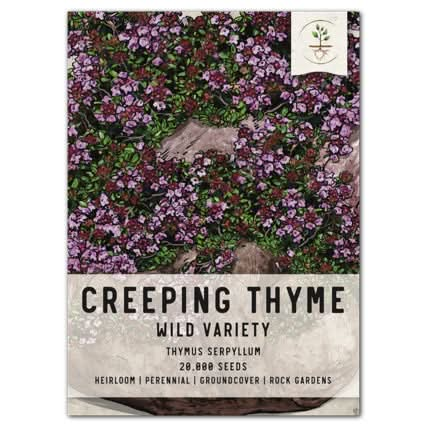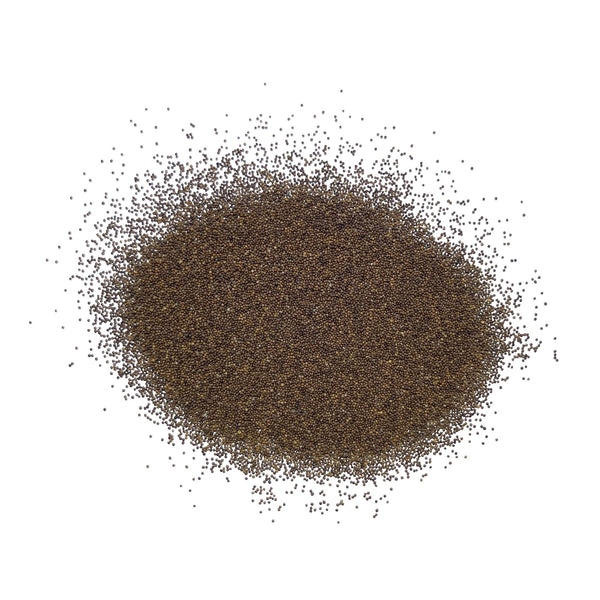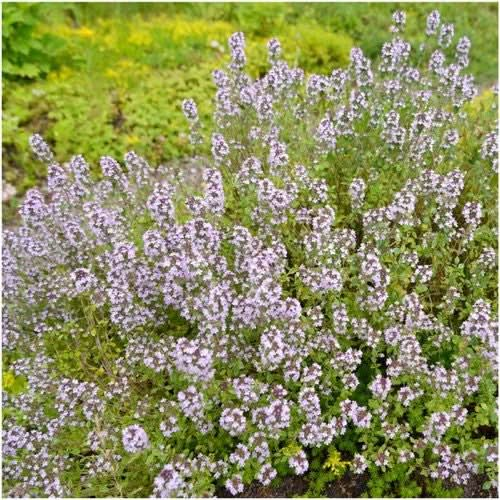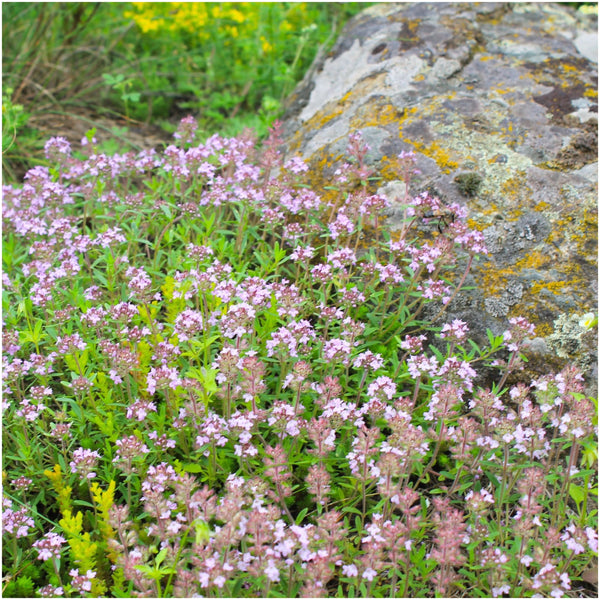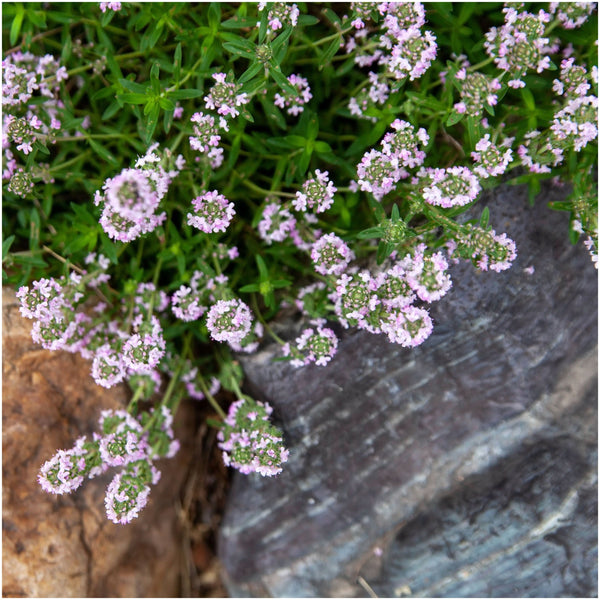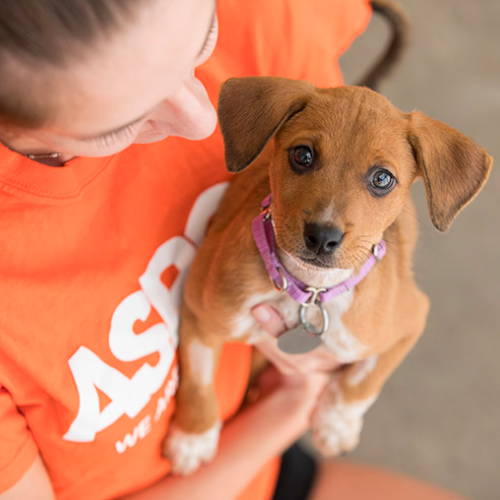Quick Facts
- Thymus serpyllum
- Type: Groundcover
- Season: Perennial
- Color: Lilac
- Height: 6" - 12" Tall
- Width: 12" - 18" spread
- Environment: Full Sun
- Zone: 3 - 9
- Notes: Used as a groundcover for rapid spreading. Attracts beneficial insects. Handles light traffic. Great for rock gardens.
Description
Grow Wild Creeping Thyme from fresh Thymus serpyllum seeds. Wild Creeping Thyme is a low growing herb that produces masses of beautiful purple flowers. Each branch bares clusters of roughly 10 to 30 flowers atop slender stems. The plants are compact, forming stems that lay down to trail the ground beneath. Each plant grows to a mature height of only 6 to 12 inches tall.Wild Creeping Thyme is often used as a groundcover plant because of its fast, trailing growth habits. The plants can cover a large area with a few thousand seeds and will flower a few weeks later. Wild Creeping Thyme is popularly sown in rock gardens, along borders, fences & walkways, in containers & pots, or directly in the garden. This versatile groundcover also looks great when grown between pavers and stepping stones as well. The uses of Wild Creeping Thyme are endless.
Grown as a perennial flowering herb, Wild Creeping Thyme will establish a deep root system. This allows it to grow vigorously through the summer months, later wilting with the first frost. Wild Creeping Thyme then returns the following year from its deeply established root system.
Wild Creeping Thyme is known to attract an array of beneficial insects. Some include butterflies, bumblebees & honey bees as well. Large Blue butterfly larvae in particular, will find this plant very tasty and use it as a food source.
Sowing The Seed
Wild Creeping Thyme seeds can be sown indoors or directly outdoors. If you don't mind transplanting this plant, sowing indoors, in peat pots is recommended. Sow your Wild Creeping Thyme seeds directly to the surface of the soil, allowing direct light to reach them. Do not cover the seeds with soil. Transplant outdoors when the weather is warm and all danger of frost has passed. If sowing directly outdoors, scatter the seeds to the surface of the soil, on a calm day, allowing direct sunlight to reach them.
Growing Conditions
Wild Creeping Thyme will enjoy an area that receives full sunlight for the majority of the day, but it can also tolerate partial shade as well. Sowing in temperatures of 68F to 75F is best. Wild Creeping Thyme is not too picky when it comes to soil conditions and can adapt to sandy, poor or fertile conditions. Just be sure that the soil is well draining. To increase drainage, we recommend adding a light compost to areas containing hard, compact soil. Water daily with a light mist setting so that you do not disrupt the seeds.
Germination & Growth
Your seeds will begin to germinate within roughly 7 to 10 days after sowing. The plants will grow anywhere from 6 to 12 inches tall and can spread a good 18 inches wide or more. The plants can be spaced about 12 inches apart from one another. Once established, your Wild Creeping Thyme plants will produce beautiful, lilac purple blooms throughout your garden. They can be used in rock gardens, along fences, walkways & driveways or around stepping stones & pavers.
I am excited to replace some grass with theses!
OK, here are a few ways to get thyme growing from these seeds (in no particular order!):#1 - Scatter seeds. You can actually just fling these onto the ground. Here is how: Mix the amount of seeds youd like to plant with a bit of sand. You will see that the otherwise microscopic seeds will stick to the sand grains. This will make it tons easier to scatter more evenly. Take a rake and loosen the soil a bit. Toss the sand/seed mix as evenly as you can, and water. NOTE: the seed are the kind that sprout on TOP of soil, not covered: so you can just leave them loose on the soil.Success rate: varied!! My experience was some areas got no plants at all, other areas had a surprisingly great burst of healthy seedlings rather quickly, and still another area seemed to not work out but then only months later I noticed a very impressive amount of new thyme plants suddenly growing. OK, so the results were kind of whimsical! This method was hit or miss, but by far the least amount of work if you get lucky.#2 - Jiffy pots (or other seed starter pots). Sprinkle seeds on top of the expanded jiffy pots - they only need to sit on top of the soil to sprout so dont cover the seeds. Keep moist and put in a warm place like a radiator if you can (or on top of a fridge), or a sunny window - the sprout rate is very good so you will likely have success whatever way. They should sprout in only a few days!! Thin out the seedlings, keep in good light once sprouted, and when they are bigger you can plant into bigger pots or try putting them in the ground already.Success rate: very good. Takes more work and material, but you can rely on getting thyme plants with this method. The bigger you let the plants get before planting out, the more success you will have with the transplant.#3 - Create the Motherlode Method: once you have a very well established plant (probably by the next summer), it is very very easy to propagate tons more with cuttings from that plant!! So, with this method - you need to grow a Big Motherlode Plant, and have it growing in an area where you are not mowing it. When you mow these thyme plants they make a super low compact spreading plant - but if you grow the same plant in a bed it makes a much bigger plant with bigger leaves that are easier to handle for cuttings. For the Motherlode Method, you need that big plant. One you get it established and thriving - you can use it as a theoretically infinite supply of cuttings to then transplant elsewhere - like all over your lawn. You can put cuttings in a glass of water - they will root quickly - or try your luck with just planting them right into the ground and keep them well watered until they root.Success rate: very very good! This is the most long-term method, but you can do it alongside the other methods and by the next warm season also start to harvest cuttings from The Motherlode. Once established, you now have a source of much more advanced plantings which is good if you are ultimately trying to do something big like plant a thyme lawn. And I assume if you are buying so many thyme seeds you have something bigger in mind than an herb garden.GOOD LUCK!!
They were as expected.
I was really excited about planting creeping thyme but it never grew. This was a fairly pricey purchase with no guarantee of germination.
Starting in trays or small cells is easy. Do it indoors or outdoors in cool-ish shade.They should grow from seed into a size ready for first transplant in 8-10 weeks. They divide very easily so a single start of a dozen seeds in a small cell could be transplanted into 3-4 larger cells or pots. Repotting success in part shade is essentially 100% for thyme (all mints transplant well and roots are extremely tolerant of disturbance).For sowing: You need a prepared soil surface and moderate or slightly cool weather. Shade cloth or screening might be a good idea.

